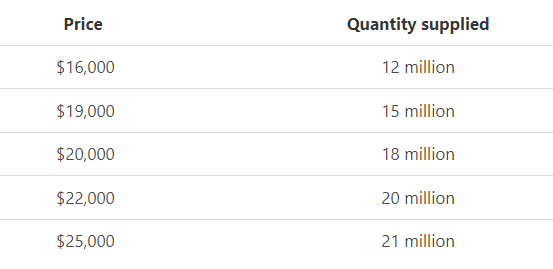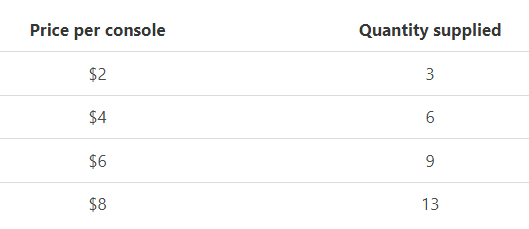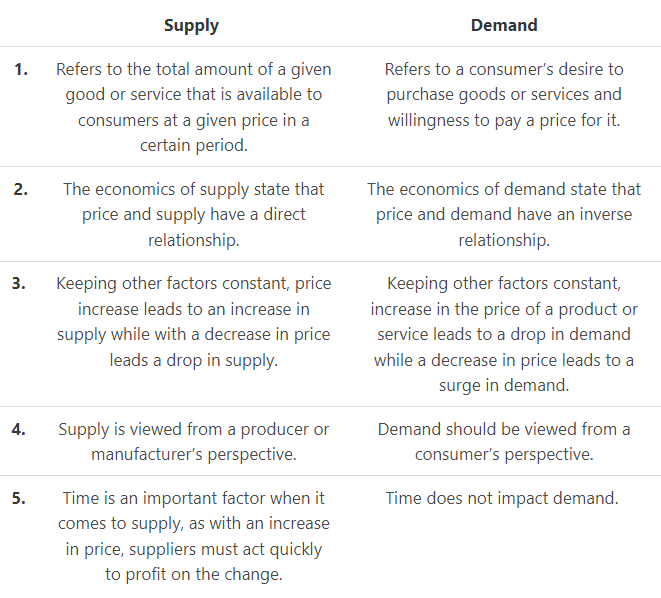“Production or manufacture” is the process of converting raw materials into finished goods. These finished goods are then sold in the market to meet customer’s need and requirement. Supply apart from being just a number is a very important factor in determining the pricing of goods and/ or services. In this article, we will understand how a producer determines how much of a product are to be manufactured and supplied in a given period, the elements in the market which affect supply and the basic difference between the two major forces in economics, namely demand and supply.
What is Supply?
- It is a crucial economic concept that refers to the total amount of a given good or service that is available to consumers at a given price during a specific period.
- In economics, we have the producer or manufacturer who makes products or offers services while on the other hand, we have consumers who buy them.
- Supply is the ability and willingness of the producer to supply products at given prices, keeping other factors constant such as taxes, changes in production raw materials etc.
- While demand measures how many consumers are willing to buy a product at a given price. We will look at this relationship later in the article.
- Supply views the relationship between the supply of a product or service and price from the perspective of the manufacturer and not the consumer.
Economics of Supply
- The law of supply dictates that there is a positive relationship between the quantity that suppliers are willing to sell and the price of a product or service, while keeping other factors constant.
- It means an increase in price will result in an increase in supply.
- While a decrease in price will result in a decrease in supply.
- Businesses are constantly seeking profits and therefore as the price of a good or service goes up, the quantity that suppliers are willing to produce also increases.
Example 1: When the price of a car rises, it motivates companies seeking profits to increase the supply of the units. This means the companies hire more employees, open more dealerships, keep the outlets open for longer hours and invest in more trucks to ship the cars to their outlets.

Example 2: ABC bakery sells donuts to its consumers at $1.50 each and cupcakes at $2 each. At this rate, the bakery can sell 200 pieces each of cupcakes and donuts earning them $300 for the week.

Customers enjoy the cupcakes more than the donuts and start paying more for it. This prompts the bakery to focus on cupcakes to achieve the best profit. They increase production of cupcakes and reduce the production of donuts.

We observe that price has a positive relationship with supply, as the bakery earns more from cupcakes than donuts.
Example 3: A furniture company pays $15 per hour to their employees for a 40-hour workweek and pays overtime of $22.50 per hour.
The employees work between 40-45 hours a week in this system. Employee C put in an extra 5 hours; employee B works an extra 2 hours while Employee A does not bother to work extra hours.

To supply for big order, the employer decides to increase the overtime hours pay which leads to an increase in the supply of hours put by the employees.
From the table below, we can observe that Employee A worked 5 extra hours, B worked 8 hours while Employee C worked the most with 10 extra overtime hours.

The law of supply works around us in different ways and the above examples are some of the ways.
Supply Curve
- A supply curve is a graphical representation of the direct relationship between the price of a product or service and the quantity supplied for a given period.
- The supply curve was first used in the 1870s by English economic texts and then made famous in the textbook ‘Principles of Economics’ by Alfred Marshall in 1890.
- On the graph, the price is plotted on the left vertical axis while the quantity supplied appears on the horizontal axis.
- A supply curve moves upwards from left to right, as per the law of supply. That is, as the price of given goods increases the quantity supplied also increases.
- The price is an independent variable and the quantity is the dependent variable.
Example: The following table shows the number of hypothetical products XYZ limited supplied during a week, at different prices.

The above data shows that the company supplied 3 units at a price of $2 per unit, 6 units at a price of $6, 9 units at a price of $9, and 13 units at a price of $8. The week supply tends to increase as the unit price increase as per the law of supply.

The Supply curve helps us to observe the relationship between price and quantity supplied in this case.
Difference between Supply and Demand

Factors of Supply
Supply can be influenced by several determinants that are termed as factors of supply.
1. Price of the product or service
- It is the main factor that influences the supply of a product or service.
- There is a direct relationship between the price of a product and its supply.
- If the price of a product increases than the supply also surges and if the price decreases, it leads to a drop in supply as well.
2. Price of related goods or services
- Prices of complementary products or services can also affect the supply of a product.
- For example, if the prices of pepper crop increases, farmers tend to grow more pepper than other crops leading to a decrease in other crops in the market.
- These farmers might be growing wheat before but to make a handsome profit on pepper they change their product, which affects the supply of wheat in the market.
3. Price of production factors (raw materials or inputs)
- Inputs such as land, equipment, energy, machines, and raw materials are required at the time of production.
- Producers will be willing to produce more goods and increase supply if these factors are available in sufficient quantity and at lower prices.
- For example, the availability of cheap labor and raw material nearby the factory will help in reducing labor and transportation cost, leading to an increase in production and supply.
4. Productivity of labor
- Motivated workers can create a significant increase in output.
5. Technological improvements
- Improvements in technology such as automation of production systems can reduce production costs, make production more efficient and lead to expansion of capacity of the producers.
- For example, development of pesticides, fertilizers and high yield seeds equipped the farmers to increase their supply of food grains in the market.
- Another example is the mobile phone industry which began with mobile having a storage capacity of a few megabytes and expensive. With technological advancements, now we can buy mobile phones with hundreds of gigabytes of capacity at lower prices.
6. Producers expectations
- Companies are always trying to maximize profits, and thus a producer’s expectations and objectives can also affect the supply of the product.
- For example, if a business produces 48-megapixel camera phones and gets to know that their a bigger brand is soon going to introduce 108-megapixel camera phones in the market, they may decide to increase production today, thereby increasing the supply of 48-megapixel phones because of what they expect to happen in the future.
7. Government Policies
- Government is ever-changing with their policies and new programs and these can have a significant impact on supply.
- Factors such as government subsidies when implemented to industry allows producers to produce more goods and services.
- This increases the overall supply of the good or service, which increases the quantity demanded.
- For example, U.S. government subsidies for corn production for biofuels increased usage of 40% of the country’s corn crop to make ethanol. This shifted production of corn crops and decreased the usage of corn crops for the food industry.
- While an increase in taxes raises the cost of production and reduces the supply because of lower profit margins.
- For example, the US government imposes a tax on alcoholic beverages that collects about $8 billion per year from producers. As taxes are treated as costs by business, it leads to a decrease in supply.
8. Other factors
- Factors such as climatic conditions can affect supply as in the case of agricultural products.
- For example, the supply of climate-specific crops increases with better monsoon and decreases during drought.
- In the second of half of 2009, drought-affected the output of wheat in northern China bringing down their usual supply.
- Other factors such as the decline in currency prices can make goods or services from foreign countries cheaper leading to an increase in imports.
Summary
- It is a crucial economic concept that refers to the total amount of a given good or service that is available to consumers at a given price in a certain period.
- There is a positive relationship between the quantity that suppliers are willing to sell and the price of a product or service, keeping other factors constant.
- An increase in price will result in an increase in supply while a decrease in the price will result in a decrease in supply.
- A supply curve moves upwards from left to right, as per the law of supply. That is, as the price of given good increases the quantity supplied also increases
- In economic terminology, supply is not the same as quantity supplied.
- A supply curve is a graphical representation of the direct relationship between the price of a product or service and the quantity supplied for a given period
- The economics of supply state that price and supply have a direct relationship. While demand and price have an inverse relationship.
- Supply is viewed from a producer or manufacturer’s perspective. And demand should be viewed from a consumer’s perspective.
- Supply can be influenced by several factors of supply such as the price of the product or service, price of related good or service, price of production inputs, productivity of labor, technological improvements, producers’ expectations, government policies and other factors.
- Supply is one of the catalyst factor to determine the pricing of goods and services in the given market.
FAQs
1. What is supply?
In economics, supply refers to the total amount of a given good or service that is available to consumers at a given price in a certain period of time.
2. What are the types of supply?
There are five types of supply:
1) Market supply - This is the total quantity of a good or service that producers are willing to sell at a given market price.
2) Short-term supply - This is the total quantity of a good or service that producers are willing to sell in the short-term, usually less than a year.
3) Long-term supply - This is the total quantity of a good or service that producers are willing to sell at a given market price over a long period of time.
4) Joint supply - This is the total quantity of a good or service that is supplied by two or more producers at a given market price.
5) Composite supply - This is the total quantity of a good or service that is supplied by two or more producers at a given market price.
3. What is the importance of supply?
The most important implication of supply is that it drives price. When the quantity supplied increases, the price falls, and when the quantity supplied decreases, the price rises.
4. What is the supply theory?
The law of supply is a theory that states that there is a positive relationship between the quantity that suppliers are willing to sell and the price of a product or service, keeping other factors constant.
5. What is the difference between supply and demand?
Supply is the willingness and ability of producers to sell a good or service at a given price. Whereas, demand is the willingness and ability of consumers to buy a good or service at a given price.
